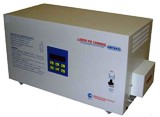Three-phase stabilization
 First, a little excursion into theory. There are single-phase and three-phase power networks. The electrical network that connects most household appliances—washing machines, dishwashers, televisions, and computers—is single-phase. This network mainly covers apartments located in multi-storey buildings. But in a private house, along with a single-phase network, a three-phase electrical network is used. In city apartments, household appliances are practically not used, which would ensure the use of three-phase power supply. However, in a private house, such equipment is used quite actively, for example, for heating the boiler, garage doors, alarms and other electrical appliances. The difference between the two power schemes is fundamental: the voltage of a three-phase system is 380 volts, a single-phase system is familiar to all 220.
First, a little excursion into theory. There are single-phase and three-phase power networks. The electrical network that connects most household appliances—washing machines, dishwashers, televisions, and computers—is single-phase. This network mainly covers apartments located in multi-storey buildings. But in a private house, along with a single-phase network, a three-phase electrical network is used. In city apartments, household appliances are practically not used, which would ensure the use of three-phase power supply. However, in a private house, such equipment is used quite actively, for example, for heating the boiler, garage doors, alarms and other electrical appliances. The difference between the two power schemes is fundamental: the voltage of a three-phase system is 380 volts, a single-phase system is familiar to all 220.
A voltage stabilizer in modern conditions is extremely necessary for use in the power supply network at home. It's no secret that short-term voltage surges, simply called surges, which happen from time to time, lead to failures of electrical equipment for various purposes.In this context, a three-phase surge is more dangerous for appliances than a single-phase one. Remember the 220 and 380? It turns out that three-phase stabilizers protect equipment that is much more expensive and important for the house from damage. At least on a cold winter's night with no TV, but you can last until the emergency brigade arrives. But without heating it is quite difficult. Therefore, installing a three-phase mains voltage regulator is the correct and reasonable solution.
Three-phase voltage stabilizers are even more necessary in production, where single-phase voltage, if used, is only in the administrative part of the enterprise. All metal cutting machines, elevators, power tools and other production elements consume three-phase electric current. It's a shame when an expensive machine breaks down due to voltage instability and requires a long and expensive repair. By installing a voltage stabilizer at the three-phase input in the factory shop or in the car service box, the owner of the equipment protects it from the worst consequences that can occur as a result of the instability of the power supply.
Lider three-phase voltage stabilizers of various models perform quite well in protecting electrical equipment from power supply instability. The products are designed to operate over a wide voltage range, equalizing the supply voltage, even with significant deviations. These stabilizers are also good in terms of reliability. Due to the absence of mechanical components in the design, the service life of electronic voltage stabilizers is an order of magnitude longer than that of electromechanical analogues.Let's say without exaggeration: "Leader" stabilizers reliably protect the integrity and efficiency of your equipment.
